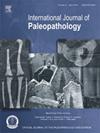听骨链变化揭示了中世纪意大利中部农村(托斯卡纳10 -12世纪)的中耳炎症
IF 1.5
3区 地球科学
Q3 PALEONTOLOGY
引用次数: 0
摘要
目的通过分析听小骨的病理变化,评估意大利中部Pieve di Pava中世纪农村地区慢性中耳炎的患病率,并探讨农村环境中耳炎症的具体危险因素。材料共检查了119个个体(20个未成年个体和99个成年个体)的224个小骨。方法采用体视显微镜观察破骨细胞和成骨细胞com相关骨改变。结果39例患者(25 %的未成年者和34.3% %的成年者)的52个小骨出现了com相关的骨改变,成年男性和女性的差异无统计学意义。蚀点是最常见的病变类型(82.7 %),而新骨形成较少见(13.5 %)。结论与西欧和东北欧的中世纪城市遗址相比,乡村居民的慢性中耳炎发病率较低。这可能是由于室内空气污染和过度拥挤等城市风险因素的暴露减少。相反,农村的特定因素,如农业、畜牧业和手工业活动,可能影响了观察到的患病率。意义听骨上广泛的病变类型及其严重程度有助于我们在古病理学中提供评估COM的诊断标准。局限性:无法检查每个人的所有小骨,以及与成人相比,成年前的小骨数量有限。对未来研究的建议进一步以考古人群为基础的研究,对地中海欧洲不同时期和城市/农村环境的听骨进行研究,可以从历时性的角度深入了解慢性中耳炎的流行情况。本文章由计算机程序翻译,如有差异,请以英文原文为准。
Ossicular chain changes revealed middle ear inflammation in medieval rural central Italy (Tuscany 10th-12th century)
Objective
To assess the prevalence of chronic otitis media in the medieval rural site of Pieve di Pava (central Italy) by analysing pathological changes in auditory ossicles and to investigate specific risk factors responsible for middle ear inflammation in a rural environment.
Materials
A total of 224 ossicles from 119 individuals (20 pre-adults and 99 adults) were examined.
Methods
Stereomicroscopic observation was used to evaluate osteoclastic and osteoblastic COM-related bone changes.
Results
COM-related bone changes were observed in 52 ossicles, pertaining to 39 individuals (25 % of pre-adults and 34.3 % of adults), with no statistically significant difference between adult males and females. Pitting was the most common lesion-type (82.7 %), while new bone formation was less common (13.5 %).
Conclusions
Compared to urban medieval sites in western and northern-eastern Europe, the individuals from rural Pieve di Pava exhibited lower rates of chronic otitis media. This may be attributed to reduced exposure to urban-risk factors, such as indoor air pollution and overcrowding. Conversely, rural-specific factors, like farming, husbandry, and craft activities, might have influenced the observed prevalence.
Significance
The broad range of lesion-types on the ossicles and their severity helped us to provide diagnostic criteria for assessing COM in paleopathology.
Limitations
The inability to examine all ossicles per individual, as well as the restricted number of pre-adults compared to adults.
Suggestions for Future research
Further archaeological population-based studies examining ossicles from different time periods and urban/rural settings across Mediterranean Europe could provide insights into the prevalence of chronic otitis media with a diachronic perspective.
求助全文
通过发布文献求助,成功后即可免费获取论文全文。
去求助
来源期刊

International Journal of Paleopathology
PALEONTOLOGY-PATHOLOGY
CiteScore
2.90
自引率
25.00%
发文量
43
期刊介绍:
Paleopathology is the study and application of methods and techniques for investigating diseases and related conditions from skeletal and soft tissue remains. The International Journal of Paleopathology (IJPP) will publish original and significant articles on human and animal (including hominids) disease, based upon the study of physical remains, including osseous, dental, and preserved soft tissues at a range of methodological levels, from direct observation to molecular, chemical, histological and radiographic analysis. Discussion of ways in which these methods can be applied to the reconstruction of health, disease and life histories in the past is central to the discipline, so the journal would also encourage papers covering interpretive and theoretical issues, and those that place the study of disease at the centre of a bioarchaeological or biocultural approach. Papers dealing with historical evidence relating to disease in the past (rather than history of medicine) will also be published. The journal will also accept significant studies that applied previously developed techniques to new materials, setting the research in the context of current debates on past human and animal health.
 求助内容:
求助内容: 应助结果提醒方式:
应助结果提醒方式:


